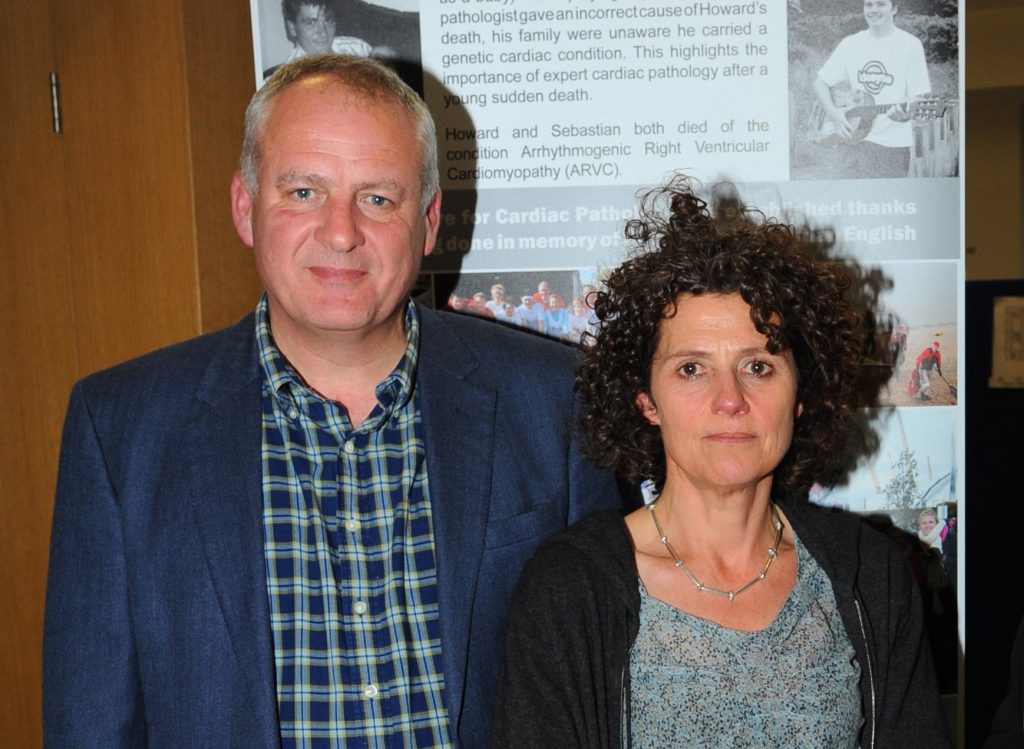Stephanie and Rupert Hunter are avid campaigners for Cardiac Risk in the Young.
Stephanie and Rupert threw themselves into fundraising for Cardiac Risk in the Young after Stephanie’s son Sebastian died playing rugby, eleven years after her first husband and Sebastian’s father died in the same tragic circumstances. Both had suffered from an unidentified inherited heart condition.
The couple, from Haslemere, are now dedicated campaigners of the dangers of heart abnormalities in young people, raising hundreds of thousands of pounds for the pathology lab at London’s Royal Brompton Hospital, which has recently been relocated to St George’s Hospital in London.
Every week in the UK, 12 apparently fit and healthy young people (aged 35 and under) die from a previously undiagnosed heart condition. Sport does not cause these deaths but it can increase a person’s risk if the underlying problem remains undetected.
Haslemere Rugby Club, ex-England player Simon Halliday and the schools Sebastian attended – Amesbury School and Lord Wandsworth College – joined forces with the Hunters to raise £620,000 for the CRY Centre for Cardiac Pathology. Haslemere Rugby Club continues to hold an annual memorial match, which has raised thousands for Cardiac Risk in the Young.
In a personal letter to Stephanie and Rupert, Prime Minister Theresa May said:
“Your fundraising efforts and work with ‘Cardiac Risk in the Young’ have made an important contribution to awareness, research and treatment for heart abnormalities in young people. It is a wonderful tribute to the lives of Howard and Sebastian.”
Stephanie and Rupert said:
“It is a great honour to receive this recognition in memory of Howard and Sebastian who both died suddenly aged 32 and 15 respectively, and for our wonderful and brave children, Sabrina, Titus, Marcus and Rory. However, the award is for everyone who has had their lives so cruelly cut short at such a young age, as a result of an undiagnosed heart condition. It is also for their amazing families and for the fantastic work that CRY does in supporting us all.
In 2004, CRY listened and reacted to our family’s plea that multiple deaths in families with an inherited heart condition could not be allowed to continue. The CRY Pathology Unit set up in Howard and Sebastian’s name, funded by the generosity of our incredible friends and the continued support of CRY patrons, especially Simon Halliday, John Inverdale and Pixie Lott. It is the leading cardiac pathology unit in the country and its existence is saving and has saved many lives in those families who have suffered the loss of a family member through sudden death with a previously undiagnosed cardiac condition. Without the vision of Alison Cox and the entire CRY team, this would not have been possible.
Our family, like many, are so grateful to CRY for existing. We would have been alone and lost without them.”
Dr Steven Cox, Chief Executive of Cardiac Risk in the Young, said:
“The incredible support from Stephanie, Rupert and all of their family and friends who have helped CRY in memory of Howard and Sebastian has resulted in over 1,500 families receiving expert advice on the cause of death, through the CRY Centre for Cardiac Pathology. In the past, families would have to wait for up to 2 years to know the cause of death, but thanks to this pioneering service that was established due to Rupert and Steph’s determination and ongoing commitment to CRY, it now takes just 2 weeks. This not only provides bereaved families with essential information about how this tragedy could have happened but it also enables all first-degree blood relatives to be quickly referred and offered clinical tests to see if they may also be at risk of having the same genetic condition.
“On behalf of everyone at CRY I would like to thank Rupert and Steph for everything they have done to help and support other bereaved families as they seek answers in the face of such devastating grief.”
Alison Cox MBE, Founder of Cardiac Risk in the Young, said:
“Steph and Rupert, their families and friends have shown CRY extraordinary support during the last decade which has empowered us to develop a unique centre exclusively dedicated to determining the pathology for a young sudden cardiac death. This centre not only provides a fast track service so that the heart is returned in time for burial but also ensures a full microscopic examination of the heart. Prior to this service the Pathology could take up to 2 years and only a small tissue sample was examined making correct diagnosis much more challenging. We and the hundreds of families that have benefitted are massively indebted to their courage and commitment to this huge achievement which has had such a wide ranging impact in reducing suffering for affected families.”






